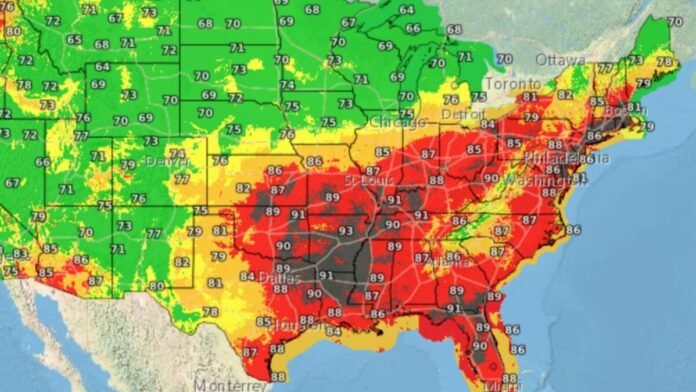Contents
Heat Dome Grips Eastern US: Understanding the Deadly Combination of Heat and Humidity
A severe heat dome has enveloped the eastern United States, posing a life-threatening risk to nearly 170 million Americans. The National Weather Service has issued heat warnings, and experts warn that the combination of high temperatures and humidity can lead to deadly heat-related illnesses. As the atmosphere warms due to global warming, the frequency and intensity of extreme wet-bulb temperatures are increasing, pushing humans closer to their physiological limit.
The current heat wave in the eastern US is a stark reminder of the dangers of extreme heat and humidity. The National Weather Service has issued heat warnings for nearly 170 million Americans, with temperatures feeling even hotter due to severe humidity. The human body’s ability to cool itself is impaired in humid conditions, leading to a higher risk of heat-related illnesses. To understand the combined physiological impact of heat and humidity, meteorologists look at the wet-bulb temperature, a critical metric for understanding human survivability in a changing climate.
What is Wet-Bulb Temperature?
Wet-bulb temperature is essentially the temperature of a wet thermometer’s bulb, traditionally measured by putting a tiny wet sock on the end of a thermometer. This measurement represents the amount of heat stress the body experiences under hot, humid conditions. According to David Romps, a professor of Earth and planetary science at the University of California-Berkeley, “The wet-bulb temperature is literally the temperature of a wet thermometer’s bulb… but a wet-bulb thermometer is not like a person in some important ways.” Humans generate body heat, which must dissipate into the air, making them warmer than a wet bulb.
Threshold for Human Survivability
Experts have long believed that a wet-bulb temperature of 35 degrees Celsius (equal to 95 degrees Fahrenheit at 100% humidity or 115 degrees Fahrenheit at 50% humidity) was the threshold at which the human body can no longer cool itself. However, recent research suggests that this threshold is actually much lower. Kat Fisher, a PhD candidate in the human thermoregulatory lab at Penn State University, notes that “a wet bulb temperature of around 87 degrees Fahrenheit [30.6 degrees Celsius] at 100% humidity is the critical threshold above which humans cannot maintain a stable core temperature if they were exposed to those conditions for hours at a time.”
Wet-Bulb Globe Temperature (WBGT)
Taking the wet-bulb temperature into account with air temperature, wind speed, cloud cover, and the angle of the Sun gives meteorologists the wet-bulb globe temperature (WBGT), a comprehensive measure of heat stress in direct sunlight. On Tuesday, July 29, the National Weather Service reported WBGT values in the high 80s to low 90s Fahrenheit (upper 20s to mid-30s Celsius) across much of the eastern US, particularly in the Southeast and Midwest. WBGT values above 90 degrees Fahrenheit (32 degrees Celsius) are extreme and can induce heat stress in just 15 minutes when working or exercising in direct sunlight.
Long-Term Implications
The current heat wave is not an isolated event, but rather a sign of things to come. Human-caused global warming is driving up wet-bulb temperatures, pushing even healthy people closer to their physiological limit. Climate models suggest that certain regions of the world could see wet-bulb temperatures regularly topping 95 degrees Fahrenheit (35 degrees Celsius) within the next 30 to 50 years. In the US, Midwestern states like Arkansas, Missouri, and Iowa will likely hit the critical wet-bulb temperature limit within 50 years.
Some key highlights of the current heat wave include:
* Nearly 170 million Americans are under heat warnings
* Severe humidity is making high temperatures feel even hotter
* Wet-bulb temperature is a critical metric for understanding human survivability in a changing climate
* The threshold for human survivability is lower than previously thought
* WBGT values above 90 degrees Fahrenheit (32 degrees Celsius) can induce heat stress in just 15 minutes
According to Romps, “Global warming is changing that, and fast.” The extreme heat is already the deadliest weather hazard in the US, with roughly 2,000 Americans dying from heat-related causes per year. Experts believe that the death toll is grossly underestimated, and there is an urgent need to adapt infrastructure, public health systems, and extreme heat response measures to the changing climate.
Conclusion
The heat dome gripping the eastern US is a stark reminder of the dangers of extreme heat and humidity. As the atmosphere warms due to global warming, the frequency and intensity of extreme wet-bulb temperatures are increasing, pushing humans closer to their physiological limit. It is essential to understand the limits of human survivability in a warmer world and take urgent action to adapt infrastructure, public health systems, and extreme heat response measures to the changing climate.
Keywords: heat dome, extreme heat, humidity, wet-bulb temperature, human survivability, global warming, climate change, heat-related illnesses, National Weather Service, WBGT
Hashtags: #heatwave #extremeheat #climatechange #globalwarming #humansurvivability #heatrelatedillnesses #NationalWeatherService #WBGT #sustainability #environmentalhealth #publichealth #infrastructure #adaptation
Source link
